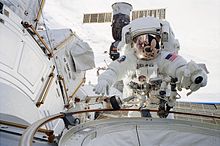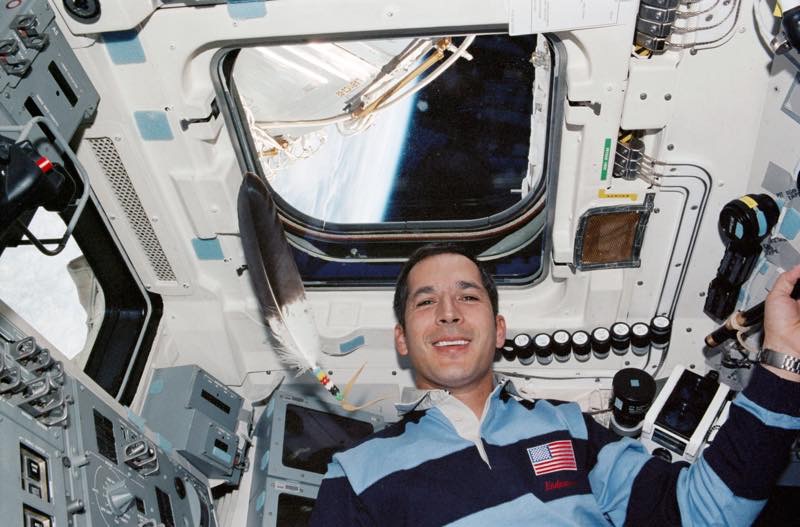By Terri Hansen
Before boarding the space shuttle Endeavour to rendezvous with the International Space Station (ISS) in 2002, Cmdr. John Herrington had a Native engineer at the Kennedy Space Center smudge him with sweetgrass and sage outside of the astronaut crew quarters, an appropriate gesture for the first Native American tribal member to fly in space.
And when he went into orbit, Herrington, a citizen of the Chickasaw Nation, brought two treasured objects with him: an eagle feather and a flute.
“I played ‘Amazing Grace’ on board the ISS while my crewmate, Don Pettit, used a vacuum cleaner hose to simulate an aboriginal didgeridoo, which he actually brought onboard; he just had not unpacked it yet,” Herrington told ICTMN. “The Native American flute I flew on my mission, a black-lacquered river cane flute, was made by a Cherokee friend, Jim Gilliland.”

Herrington still remembers the thrill of creating those sounds aboard the ISS as he orbited the Earth over and over again. He also remembers the team that put him there.
“I was honored to have the opportunity to fly in space, but I realize there were thousands of people who made it possible: technicians, engineers, scientists, medical personnel, and administrators,” he said. “Our ability to fly in space and explore is due to the collective efforts of a multitude of talented people, many of them trained in the STEM (science, technology, engineering and math) fields.”
Herrington retired from NASA in 2005 but he has been keeping busy: Last year he earned his Ph.D. in education from the University of Idaho. His dissertation research focused on the motivation and engagement of Native students in the STEM fields who had attended a NASA summer program. Native American and Alaskan Natives earned just 0.6 percent of master’s degrees in science and engineering in 2009, according to the National Science Foundation.
It’s a dismal statistic that highlights Herrington’s motivation to study different approaches to engage Native students in STEM education.
“I wanted to look at the results of tests they took before and after that summer program,” Herrington said. “I did a case study three years later where I actually interviewed those students to really find out the factors that motivated and engaged them in NASA math and science based on that summer program. I analyzed the pre- and post-tests they took, and I had the students tell me the stories of their experience.
“It was interesting because it supports the literature that I’ve read . . . My research indicated that Native students become engaged and motivated through hands-on experiential, non-competitive, collaborative learning. They like to work in groups, they like to build stuff, they like to personalize their work and see the practicality in what they’re learning related to the theory.”
In that regard, not all of Herrington’s research was conducted in libraries and classrooms. He had once worked on a surveying crew and got a sense of mathematics in action. “I was hanging off a cliff in Colorado, and these guys would shoot a beam of infrared light to a prism I held in my hand,” he recalled. “Since light travels at a constant velocity, you can determine the distance—if you know how long it took the light to travel from one point to another. If you know the angle of that beam of light, you can determine the horizontal and vertical distance, using trigonometry. They used surveying machines that could calculate these things. For the first time in my life I actually saw the practicality of mathematics in work, and it was fun!”
Over the next few years, Herrington said, he would like to extend his research, investigating the factors that stimulate and engage Native American students in STEM fields as they proceed to college and various professions.
“There is a wonderful story to be told about how successful Native American STEM students and professionals have been able to accomplish the difficult work that a STEM profession entails,” Herrington said. “The next generation of students needs to be aware of the factors that made their predecessors successful in the areas of science, technology, engineering and math.”
Elementary and high school students, Herrington added, benefit from a hands-on approach to learning.
“This applies to non-Native communities, too. Summer camps and science museums seem to accomplish this, and I wonder how we can incorporate these same learning and teaching techniques in the schools. It’s going to take everyone working together to make an impact. The thing is, it will be fun and enjoyable.” Part of that entails highlighting the accomplishments of traditional knowledge in this regard, which long predate the STEM disciplines.
“I think we should show students examples of the wonderful feats of engineering our ancestors were able to accomplish over the past centuries, using basic tools and understanding their environment,” Herrington told ICTMN. “Without the use of western mathematics or engineering, our ancestors were capable of building and inhabiting cities that exhibited tremendous engineering and scientific skill.”
Though he may be earthbound these days, Herrington still thinks of what may lie ‘out there.’

“There are billions of galaxies in the universe, with each galaxy containing hundreds of billions of stars, and we have observed planets orbiting some of our closest stars,” he said. “So the odds are incredibly high that there are planets just the right distance from a star, and have a chemical composition in their atmosphere, that could possibly sustain some form of life.”
By the time Herrington retired from NASA, he had logged more than 330 hours in space. During one of those hours, he had a realization that will remain “forever etched” in his memory. It occurred when he was poised on the end of the space station and found himself looking out across the Earth’s horizon. “There I was, 220 miles above the Earth and looking past it into the vastness of the universe,” he said. “I realized there was absolutely nothing between me and whatever else might exist out in the cosmos. The dual sensation of being alone—I was in my spacesuit tethered to a handrail on the ISS—yet not solitary, was extraordinary. “It was a moment I will never forget, and it has fundamentally changed my belief that we can’t possibly be alone in the universe.”
Read the original story at the Indian Country Today Media Network

